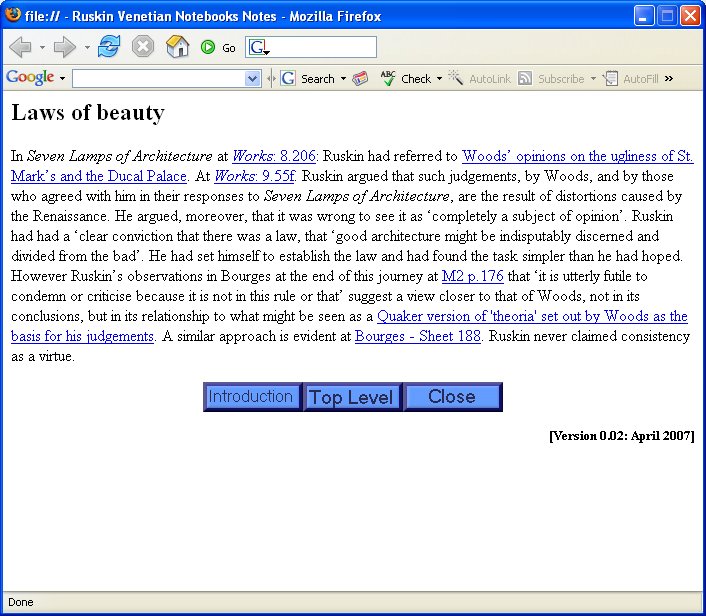 |
Access to this material is with a suitable browser such as Mozilla Firefox or Internet Explorer. Javascript and cookies need to be switched on.
The transcripts of Ruskin’s Venetian notebooks are presented in this edition as a sequence of page openings. Ruskin generally numbered the openings of a notebook from 1 upwards, distinguishing the left-hand page of the opening with a lower case ‘l’ where necessary - in this edition a capital ‘L’ is generally used for clarity. Thus opening 43 of notebook M has page 47L on the left (i.e. page 46verso) and 47 on the right.
In some cases this numbering sequence breaks down - for example, Bit book has no opening numbered 26, and openings numbered 35a and 35b between openings 34 and 36. In some cases Ruskin has partially renumbered a notebook from the other end; thus, Ruskin has numbered the last few openings of notebook M2 1 to 31, specified in this edition as 1back to 31back for clarity. Similarly Ruskin has renumbered the last few openings of Bit book 1w to 24w.
There are generally a number of pages at each end of a notebook which Ruskin has left unnumbered. Provisionally, we have numbered these openings in small Roman numbers from i upwards, where i is the front board. Thus, Door book begins i (Front board), iiL and ii (Front pastedown and Front free endpaper recto), iiiL and iii (Front free endpaper verso and Next page recto), 1L and 1, and so on; and ends 59L and 59, ivL and iv (Back free endpaper verso and Back pastedown), iv (Back board).
Entry to a notebook is to the opening which was numbered 1 by Ruskin; there will generally be some front matter earlier in the notebook.
The Transcription Page
Here is the transcription of notebook M pages 47L and 47, with 47L on the left and 47 on the right. The text can be scrolled horizontally or vertically if necessary.
 |
Unclear words are represented followed by a question mark and enclosed in square brackets, thus "[curvature?]". Indecipherable words are represented as a question mark in square brackets, thus "[?]". Non-textual elements in the text, such as drawings and diagrams, are represented by "[drawing]" or "[diagram]". The notation "[gap]" represents a significant gap in the text, perhaps where Ruskin had left space to insert a sheet or page number, but then omitted to do so. Other significant features on the page may also be represented by a phrase in square brackets.
An underlined word or phrase represents a link to a comment or explanatory note, which is opened in a separate window (see below).
At the top and bottom of each transcription page is a set of buttons. Two of them are "arrow" buttons to go to the previous or next page. There is a "Navigation" button which pops up a window which allows direct access to any page in this notebook (see below).
A further button "this notebook" opens a note in a separate window which discusses the physical properties and provenance of this notebook.
Notebooks M and M2 were transcribed in the early years of the 20th century, as part of the preparatory work for Cook & Wedderburn’s Library edition. Copies of these transcripts are held at the Ruskin Library as T7A and T7B respectively. For these notebooks the buttons "RL T7A" and "RL T7B" give access to copies of these transcriptions, so that they can be compared to the transcriptions for this edition.
The Navigation Window
 |
The navigation window contains a scrollable list of all the pages in this notebook, including front and back matter and any pages renumbered from the end of the notebook. Clicking on a particular page number closes the navigation window and opens the specified page in the main window.
At the bottom of the navigation window are three buttons:
The Facsimile Page
On the transcription page the "Facsimile" button displays the facsimile of this opening in the main window:
 |
If there is a significant amount of upside-down material on this opening, then two facsimiles are displayed, one above the other, of the opening upright and inverted.
As with the transcription page, there are left and right arrow and navigation buttons, a "a this notebook" button, and a "transcription" button to return to the transcription of this opening.
The Notes Window
 |
The note window displays text and possibly one or more images. Clicking on an underlined word or phrase brings another note into the notes window. Bibliographical references are linked to an appropriate entry in a note called "Bibliography". Clicking on a reference to one of the notebooks, such as Notebook M p.176, closes the note window and opens that page in the main window. Clicking on a reference to the Library Edition, such as Works, 8.206 closes the note window and opens that page in the main window; note that not all volumes of the Library Edition are available in this electronic edition.
Where possible a civic number and a reference to the appropriate "Tavola" (map) number in Nadali & Vianello (1999) is given for each building in Venice.
At the bottom of the note window are three buttons:
 |
 |
 |
[Version 0.05: May 2008]